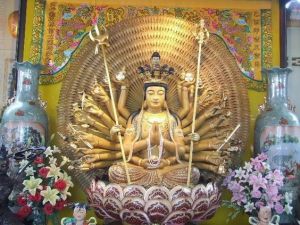Avalokites'vara transformed into 1000 arms 1000 eyes Kuan-yin
Ambiguity of Avalokites'vara and Scriptural Sources for the Cult of Ken-yin in China
Associate Professor, Rutgers University
中华佛学学报第十期
页409-464
中华佛学研究所发行
1997. 7月出版
By far the most familiar image of Kuan-yin is the chaste and filial daughter represented by Princess Miao-shan . As Glen Dudbridge
demonstrated in his studies, the core of the legend can be traced to the stele inscription entitled "Biography of the Bodhisattva of Great Compassion" (Ta-pei P'u-sa chuan) composed by Chiang Chih-ch'i ( 1031-1104) who came to Ju-chou, Honan, as its new prefect in 1099. He became friends with the abbot of Hsiang-shan Ssu in Pao-feng county which housed a Ta-pei (Thousand-eyed and Thousand-armed Kuan-yin) Pagoda
and was the pilgrimage center for the Kuan-yin cult. The fame of the temple and the pagoda rested on the legend that Princess Miao-shan, who was an incarnation of Kuan-yin, underwent the apotheosis on this very site.
Based on what the abbot told him, Chiang wrote the account which was penned by the famous calligrapher Tsai Ching and inscribed on a stele in
1104. When Chiang served as the prefect of Hangchow during 1102-1103, he brought the story with him and the monk of Upper T'ien-chu Monastery, another pilgrimage center for Kuan-yin worship, had the same story carved on a stele in 1104 (Dudbridge 1978, 10-15; 1982, 589- 594).(11)
Although the legend of Miao-shan was already known in the Sung, the fully developed story, however, was set forth in the Ming novel -The Complete story of Kuan-yin of the South Sea Nanhai Kuan-yin (ch'uan-chuan), the Ming ch'uan-ch'i drama - Story of Hsiang-shan
(Hsiang-shan chi), and the early Ch'ing sectarian text True Scripture of Kuan-yin's Original Vow of Universal Salvation (Kuan-yin chi-tu pen-yuan chen-ching, preface dated 1667.
All the works cited above, moreover, were in turn based on the Precious Volume of Hsiang-shan (Hsiang-shan pao-chuan. The earliest surviving edition was from the Ch'ien-lung era in the 18th century, although it bore a preface dated to 1103 written by a monk named P'u-ming of
Upper T'ien-chu Monastery, who cannot be otherwise identified. Even if the preface was spurious, the "precious volume" was clearly written by the Ming, for it was already referred by this title in the 1550s.
The story, in short, is the following.(12)
Miao-shan was the third daughter of King Miao-chuang who ruled an unspecified kingdom in an unspecified time. She was by
nature drawn to Buddhism, keeping a vegetarian diet, reading scriptures by day and practicing Ch'an meditation at night from an early age.
The king had no son and hoped to choose an heir from among his sons-in-law. When Miao-shan reached the marriagible age of nineteen, she refused to get married, unlike her two elder sisters who had both obediently married the men chosen by the father.
The king was greatly angered by her refusal and punished her with various ordeals. She was first confined to the back garden and subjected to hard
labor. When she completed the tasks with the aid of gods, she was allowed to join a nunnery to undergo further trials in the hope of discouraging her from pursuing the religious path.
She persevered and the king burned down the nunerary, killed the five hundred nuns, and had Miao-shan executed for her unfilial behavior.
While her body was safeguarded by a mountain spirit, Miao-shan's soul toured hell and saved beings there by preaching to them. She returned to the world, went to Hsiang-shan, meditated for nine years and achieved enlightenment.
By this time, the king had become seriously ill with a mysterious disease which resisted all medical treatment. Miao-shan, disguised as a mendicant monk, came to the palace and revealed the only remedy which could save the dying father: a medicine
concocted with the eyes and hands of someone who had never felt anger. She further told the astonished king where to find such a person.
When the king's messengers arrived, Miao-shan willingly offered her eyes and hands. The father recovered after taking the medicine and
came to Hsiang-shan with the royal party on a pilgrimage to offer thanks to his savior. He recognized the eye-less and hand-less ascetic to be no other than his own daughter.
Overwhelmed with remorse, he and the rest of the royal family all became converted to Buddhism. Miao-shan was transformed
into her true form, that of the thousand-eyed and thousand-armed Kuan-yin. After the apotheosis, Miao-shan passed away and a pagoda was erected to mark the site.
